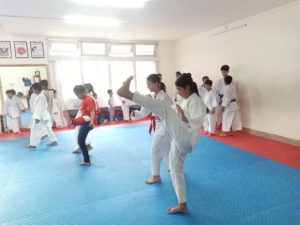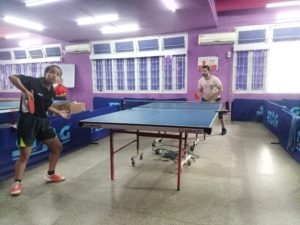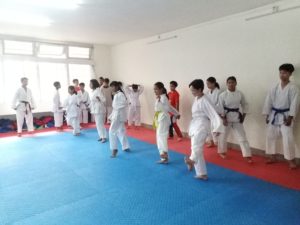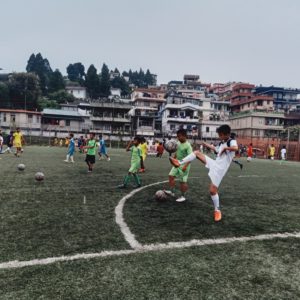By Meinam Amit Singh
 Meghalaya, a football crazy state, shows high potential in other sports too and yet the talent is untapped. Speaking of which, in 1986 the world witnessed one such athlete in Matsiewdor War Nongbri representing India in the Asian Games in Archery. She is easily the most recognised athlete from Meghalaya, but the state is yet to produce an Olympian.
Meghalaya, a football crazy state, shows high potential in other sports too and yet the talent is untapped. Speaking of which, in 1986 the world witnessed one such athlete in Matsiewdor War Nongbri representing India in the Asian Games in Archery. She is easily the most recognised athlete from Meghalaya, but the state is yet to produce an Olympian.
The modern Olympic Games, first held in 1896 with the objective to promote international understanding through sporting competition, remains the epitome of athletic excellence for most sports.
On the eve of National Sports Day (August 29), Sunday Shillong sets out on a quest to understand what it takes to reach the Olympics.
This is the day that commemorates the birth anniversary of national icon and hockey legend, Major Dhyan Chand marked by the honouring of prestigious awards like the Khel Ratna, Arjun Awards, and Dronacharya Awards by the President of the country. It is a sorry state of affairs that none of the awardees till date, have ever hailed from Meghalaya.
 Over the years Meghalaya has shown immense potential in the field of sports. This can be ascertained from the fact that the state hands out the U Kiang Nongbah Award for Sports annually on the ceremonious Meghalaya Day. Moreover, the state has also produced numerous footballers who have represented various professional clubs across the country and even played for the national team. But the buck stops here!
Over the years Meghalaya has shown immense potential in the field of sports. This can be ascertained from the fact that the state hands out the U Kiang Nongbah Award for Sports annually on the ceremonious Meghalaya Day. Moreover, the state has also produced numerous footballers who have represented various professional clubs across the country and even played for the national team. But the buck stops here!
Other than football, the state has hardly witnessed any significant achievement in other arenas. We did have an odd name making national headlines every now and then. The likes of Torak Kharpran and the Wushu and Judo athletes did make the state proud with their laurels. Kharpran won the Senior Nationals Boxing Championships in 2008, and the Wushu athletes bagged a gold and a silver during the last National Games held in Kerala in 2015. Judo also brought a bronze medal at the Kerala National Games.
But what happens to those athletes? What stopped them from converting these national medals into an Olympics medal?
The Challenges
 Almost all connected with the sports association in the state seem to think, or at least, talk of the betterment of the athletes. Yet, a basic lack of cohesion and infighting-factions, pro and anti were always observed. It is a democracy after all! All in all, the athletes always seem to face the brunt of these infighting.
Almost all connected with the sports association in the state seem to think, or at least, talk of the betterment of the athletes. Yet, a basic lack of cohesion and infighting-factions, pro and anti were always observed. It is a democracy after all! All in all, the athletes always seem to face the brunt of these infighting.
Well, there is also the infrastructure to be blamed. To produce world class athletes, the state needs to provide quality infrastructure. With only one stadium of some repute in Shillong, Meghalaya cannot possibly hope to dream of a future sporting star in the Olympics.
The state also seems to lack qualified coaches. Good coaches are a must to ensure the future crop of sportspeople are moulded and shaped towards Olympics glory.
High and low
The challenges can best be explained when we look at the example of Table Tennis and the state of the affairs of the Meghalaya Table Tennis Association (MTTA). Shillong hosted the 83rd Senior National Table Tennis Championships in April 2022. The tournament was considered a huge success. But no sooner the event ended, the Meghalaya Table Tennis Association went into a dormant phase.
It was expected that the experience the state paddlers would have gained during the national championships would have come handy in their development. But that was not the case. The U Tirot Sing Stadium, home to the state table tennis association was dismantled. The state athletes are now homeless! With no place to practice regularly, most paddlers who represented the state during the marquee event scrambled around to look for a place to hone their skills further.
 In the backdrop of such a successful event, the infrastructure should have been improved upon rather than just taken away.
In the backdrop of such a successful event, the infrastructure should have been improved upon rather than just taken away.
Sunday Shillong caught up with Banshan Diengdoh, the state coach for table tennis. He practices with a handful of the talented paddlers.
Diengdoh, who is a National Institute of Sports (NIS) qualified table tennis coach said that he is satisfied with having a place at the Jawaharlal Nehru Stadium, Polo for the talented athletes to practice. The place provided might not be adequate to nurture the future talents, but it is a beginning, he surmises.
“The tables we use are worn out. They are at least 20 years old, if not older,” Diengdoh said. “I wonder what happened to all those tables that MTTA got for the Senior Nationals,” he further inquired.
Diengdoh also spoke of his wards and their hardships. “I have a student who works in the canteen at National Institute of Fashion Technology (NIFT) during the day, attends college and still finds time to come to practice,” he said.
Diengdoh’s aim is to train his students and make them able enough so that they can become coaches themselves and train the next generation of athletes in hopes of delivering a medal and even an Olympic spot for India.
He strongly advocates for sporting associations to elect its administrative or executive members who have played the sport. “If you have not played the sport then you are not aware of the ground reality. It is impossible to improve the sporting culture by just sitting in an office and formulating policies,” he reiterated.
“Policy makers can no doubt make some significant policies for the overall mastery of an athlete, but if a sportsperson makes those policies as an administrator, it will be a total game changer,” Diengdoh continued.
Diengdoh was displeased with how the MTTA has handled the affairs of table tennis in the state so far. “I am an NIS qualified coach and yet the MTTA did not offer me the state coaching job during the Senior Nationals at SAI, Shillong. They (MMTA) have some personal grudge with me and so I was denied the opportunity to coach my wards during such an important event,” he said.
With this present infighting and lack of infrastructure haunting the MTTA, it can be safely assumed that table tennis will not see an Olympian from Meghalaya in the years to come.
Meghalaya Games
But we might be closer to the elusive Olympian, at least that is what John F Kharshiing, working president of the Meghalaya State Olympics Association (MSOA) thinks. “It takes a minimum of 10 years of habitual practice or about 10,000 hours to become an Olympian,” Kharshiing said.
“I am grateful to the current government for reviving the Meghalaya Games after 16 years,” he observed. It is the first step toward nurturing an athlete to represent India in Kharsing feels.
The 4th Meghalaya Games saw the introduction of new events like Gymnastics and Weightlifting and Kharshiing believes that it is a great way of introducing sports other than football to the youth.
A Scientific approach
The reintroduction of the Meghalaya Games is not the only thing the MSOA has pitched for, to further evolve sports in the state. They have also used science in identifying talents who could, in the future, bring laurels back to the state.
An incidental meeting between Kharshiing and Australian Olympian Ian Campbell introduced Meghalaya to the scientific approach for identifying talent in the state.
With the mantra of “adopting a scientific approach and technologies of medal winning nations,” Kharshiing with the help of the state government brought in the expertise of Campbell to unearth Meghalaya’s gems.
“We conducted the scientific testing in all the districts of the state. The results are off the charts,” Kharshiing said. “These standards were international standards and some of our children smashed them.”
Campbell and his team will submit the results of these tests, based on which the selected athletes would be sent for rigorous training.
“The athletes who excelled in these tests can take up any sport and will excel in it,” Kharshiing said.
We, however, must wait and see whether these selected youths can be nurtured as future Olympians.
The role of the parents, school and society plays an important part whether these select few take up sports other than football, as many children opted for football as their preferred sport during the tests.
“We have to engage psychologists and counsellors to make the children and their parents understand that football is not the only sport that children can excel in,” the MSOA chief asserted.
The prospect of Meghalaya doing well in sports is farfetched. Success may take time but the process of achieving it has been set in motion.
The government introduced the Meghalaya State Sports Policy in 2019 with the aim of inculcating a sporting culture in the state, through participation and excellence in sports leading to an energetic, healthy, and culturally vibrant Meghalaya.
The sports policy also talks about monetary rewards for medal winners at various meets, both national and international. This year, itself, the government handed over Rs 81 lakh to 231 sportspeople, who brought laurels to the state.
The State Sports Policy also mentions reserved jobs for medal winners, sports scholarship, and spots marks for athletes in schools and colleges. However, we have to wait and see whether these are mere printed words or actionable deeds.
Kharshiing believes: “Producing an Olympian is like growing a fruit bearing tree; you have to till the land, sow the seed, water the sapling and hope that it grows well and bears fruit plentifully.”
Well, it seems, groundwork is being done slowly, but steadily.
With the idea of Meghalaya Games being conducted on a yearly basis being floated, we surely hope that this event would be the much-needed water to our future fruit bearing athletes.



